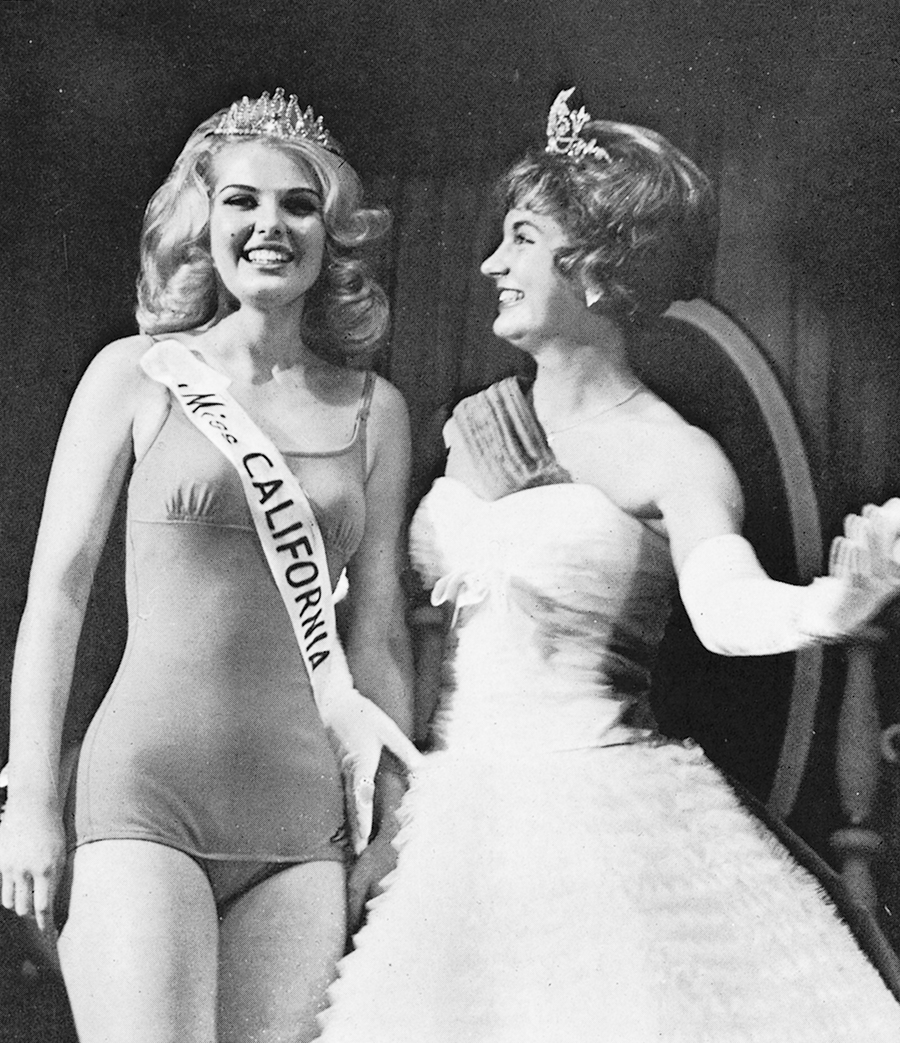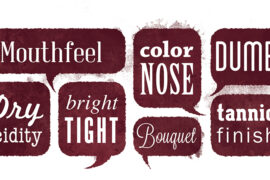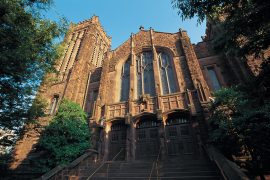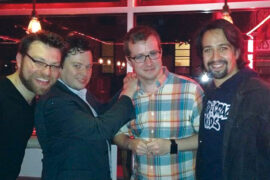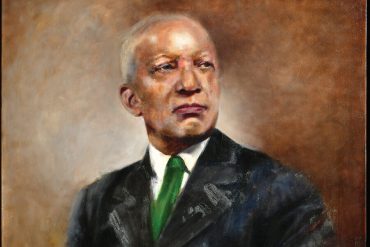A travel back to three years in the 1960s when beauty queens congregated in Huntington to vie for the crown of Miss USA and Miss United States of America.
By Joseph Platania
HQ 39 | WINTER 1999
West Virginia and national beauty pageants usually are not thought of together. Traditionally, these pageants are held in sunny seaside resorts such as Atlantic City, New Jersey and Miami Beach, Florida, or in glamorous venues such as New York City and Los Angeles. However, this tradition took a hiatus when in mid-September 1962, the 12th annual Miss USA Pageant was held in Huntington, and 44 young women who were contestants from throughout the nation arrived in town. The pageant was followed by two more held in the Jewel City: in August 1963 and August 1964.
For several weeks each summer in the early 1960s, Huntington became “a beauty capital.”
In early September 1962, children were heading back to school while Marshall fans were anxiously awaiting the start of the football season. Huntingtonians also were anticipating the beginning of a much-heralded new event. For the first time in its history, Huntington was to be the host for a national beauty contest: the Miss USA-World Pageant that would be in town September 16 – 23.
At the conclusion of the first pageant in 1962, Alfred Patricelli, the executive director of the Miss USA part of the Miss World pageant, stated in a newspaper article: “Huntington gave the pageant more newspaper and television coverage in the immediate locality than any other city that has staged such a contest. That includes Miami, Atlantic City and Long Beach, California.”
West Virginia Governor W.W. Barron said: “It was a first class promotion that brought West Virginia a great deal of national attention and publicity.”

According to an article, Larry Glick, then chairman of the Cabell-Wayne Tourist and Vacation Bureau, said the pageant was “the greatest thing that ever happened to Huntington.”
The morning of the pageant’s last full day, Saturday, September 22, the contestants were in a two-mile long parade of 85 cars that proceeded along Fourth Avenue from Seventh to 16th Streets and then on Fifth Avenue to 29th Street. Police estimated the size of the crowds that lined the parade route as more than 20,000. An article reports that “the enthusiastic sideliners ‘oohed and ahed’ as the 44 beauties passed along in convertibles.”
Other participants in the parade included ten high school bands, pageant judges, six floats, the current Miss USA, JoAnn Odum, Frankie Avalon, antique cars, equestrian units and area civic and government leaders.
The previous night, a “Grand Ball” was held at the Memorial Field House at Fifth Avenue and 26th Street.
The 10 days of pageant-related activities were action packed. “The girls attended three dances, a Marshall football game, church services; greeted visiting newsmen; attended the dedication of a new tourist information center; participated in television shows; took part in a golf tournament; were taken on a river cruise; watched a boat race; attended the opening of the local Democratic Party headquarters; were guests at a rock-and-roll show; participated in a fashion show; attended two western barbeque picnics; went horseback riding; took part in two parades; visited Gov. and Mrs. Barron in Charleston for a reception and tea; attended numerous luncheons and dinners given to them by area clubs and posed for scores of photographs.”
The article adds that such celebrities as Dagmar, Dale Robertson, Troy Donahue, Frankie Avalon, Bobby Vee, Johnny Tillotson, Hank Snow and Carl Belew added glamour and glitter to the beauty festival.

That year Miss USA headquarters was at the new Uptowner Inn, located in the 1400 block of Fourth Avenue. The pageant’s executive director was local businessman Keith L. Black.
On Saturday, September 22, the finals began at 8:45 p.m. at the Field House. The emcee was TV game show host Woody Woodbury. Following the playing of the National Anthem and with the flags of all 50 states on display and the Field House decorated with red, white and blue bunting, the contestants left the stage to prepare for the judging.
For the finals, the twelve judges included Dagmar, Frankie Avalon, Dick Hinds (Dagmar’s husband), several local men and women, California Congressman James Corman, newspaper columnist Peter Mastronardi and William D. Birke, president of the Huntington Publishing Company.
After the first round of judging, half of the contestants, 22, returned on stage for the evening gown competition. “They were introduced individually as they neared the judges’ section,” states the story. They then returned to the dressing room to prepare for the swimsuit competition.
During the long evening, the field of 44 was narrowed to five finalists. At 12:20 a.m., Sunday, September 23, the winner was announced “amid the applause of 6,000 enthusiastic spectators,” states a front-page article published along with several large photographs of the crowning of the new beauty queen. Miss USA-World for 1963 was Amedee Chabot, Miss California, an 18 year old with long blonde hair from Northridge, California. She was described as being 5’8″ and “wearing a stunning red swimsuit,” adding that “she keeps her form by lifting weights.”
The winner won a new wardrobe and an all-expense paid trip to Europe, first to Paris for a week and then to London in early November for the Miss World contest. An article states that the 1962 pageant was “one of the most spectacular events ever held in West Virginia.”

That the Miss USA-World contest came to Huntington in the first place is attributed to the persistence of JoAnn Odum, a Huntington woman who was Miss USA for 1961-62. Odum won her title in the pageant held in New York City’s Carnegie Hall in August 1961. Also involved in bringing the pageant to Huntington was Keith L. Black.
An article explains that “The Miss USA franchise had been offered to the city of Huntington by the Miss World directors in London by virtue of JoAnn Odum’s success in winning 1962s contest and then placing sixth in the Miss World competition.”
The article adds that the offer was “turned down by the city but Miss Odum did not want to let such an opportunity slip by her home town. She called Black, who had just finished last year’s Teenage Miss America Pageant, and he flew to a meeting with Miss World officials. He came home with the franchise and the responsibility of staging Miss USA of 1962-63.” Because of the pageant’s success, the beauty contest returned to Huntington the following year for the last two weeks of August.
As was the case in the 1962 contest, more than a month prior to the 1963 pageant, photographs of contestants, usually clad in a swimsuit, and with a brief amount of information about each young woman, began prominently appearing in either the morning Herald-Dispatch or in the afternoon Huntington Advertiser. This publicity generated a great deal of interest in the upcoming event.
As early as August 7, 1963 (ten days before the arrival of the first contestant), “downtown Huntington began to take on a festive air. Banners and bunting were flying on Third Avenue.” The beauty festival began on August 18 with the arrival and checking-in of contestants at pageant headquarters at the Frederick Hotel on Fourth Avenue and 10th Street.
Beauty contest winners representing 36 states and more than half a dozen major cities sent their candidates to take part in the pageant.
During the first week the contestants were taken on a three-day tour of the state that included Parkersburg and Blennerhassett Island, Charleston and the State Capitol, and Beckley for the outdoor drama “Honey in the Rock” and a tour of an exhibition coal mine.
Other pageant-related activities included “The World’s Largest Championship Rodeo” at the Field House, an event that featured TV “Bonanza” star Lorne Greene; a golf tourney at the Glenbrier Country Club on Route 2, bowling, a barbeque, a fashion show, a high school football game, a nighttime gathering of the beauty contestants, a U.S. Navy air show featuring the flying team of the Blue Angels, a Miss USA Grand Ball and a Grand Parade.
Celebrities involved in the pageant were TV Western star Clint Walker, of “Cheyenne” fame, actress Patty Duke, and stage, movie and television star Gordon MacRae, who headlined the entertainment program for the finals.

A fashion show took place on the Thursday night before the finals with the contestants as models at the Field House event which drew an audience of almost 4,000, states an article. On Friday night contestants and celebrities joined the public at the Field House for the Grand Ball with entertainment by local bandleader Mel Gillispie and his orchestra. Contestants were escorted by members of a Marshall fraternity.
According to a news story, there were eleven judges for the finals including JoAnn Odum, Huntington’s former Miss USA who captured the title in 1961; Eva Gabor, TV entertainer and actress; Milton Ferguson, Huntington and Wayne attorney and former state tax commissioner, Fred Haddad, president of Heck’s Inc. of St. Albans; and Cecil Thompson of Ft. Lauderdale, Fla., a former Huntington mayor.
Amedee Chabot, Miss USA for 1963 who had won her title in Huntington the previous year, was at the 1963 finals to help crown her successor. A crowd of 6,000 filled the Field House for the finals that began at 8:30 on Saturday night. The contestants were introduced alphabetically by state and paraded in swimsuits of red, white and blue.
Shortly after 10 p.m., the field was narrowed to 15 semi-finalists. The winner and Miss USA-World for 1964 was 18 year old Michele Metrinko, Miss New York City and a student of foreign service at Georgetown University. Miss Metrinko was described as 5’8″ with blonde hair and blue-eyes.
In late August 1964, Huntington again geared up for another national beauty contest. This time it was the Miss United States Pageant. Pageant headquarters were in the Prichard Hotel at 6th Avenue and 9th Street.
The pageant had its share of celebrities including six-foot-six TV Western star Clint Walker, who fell off his horse at the rodeo for the 1963 Miss USA Pageant. It adds that at the 1964 pageant, Walker “declined to get on a horse.”
A new feature in the pageant was that 12 of the 29 contestants were selected as semi-finalists in the first round held on Friday night, August 28, at the Field House. “The public and contestants won’t know who the 12 finalists are until the Saturday night finals,” states an article.
During the semi-finals, entertainment was furnished by The Lawrence Welk Trio featuring songs by Jimmy Roberts and Joe Feeney and backed up by local bandleader Mel Gillespie’s orchestra.
On Saturday morning, there was a parade with 46 cars including eight high school bands that moved along Fourth Avenue from Seventh to 16th Street, while the contestants rode in a fleet of white convertibles.
In an August 29 news story, pageant executive director Keith L. Black predicted that “If all went well, the pageant would surpass the Miss America contest in Atlantic City within a few years.”
For the Saturday night finals, Michael Landon, “Little Joe” of the TV Western “Bonanza,” Donna Douglas, “Elly Mae” who was on the TV series “The Beverly Hillbillies,” and Jim Roberts of “The Welk Trio,” were on the entertainment program between segments of the competition leading to the selection of the new Miss United States.
Rick Jason of the TV series “Combat” was emcee for the finals.
An article reports that the pageant winner and new Miss United States would receive a $10,000 prize -$5,000 in cash and $5,000 in scholarship money to the accredited college of her choice.
Unlike the Miss USA pageant finals in 1962 and 1963, there was a question-and-answer segment of the Miss United States finals.
Around midnight, August 29, 1964, the pageant winner and Miss United States for 1964-65 was selected by the panel of judges. The new beauty queen was Miss Illinois, Donna Rae Wood, “a blonde beauty” from South Holland, Illinois.
Miss West Virginia was named “Miss Photogenic.”
During all three national beauty pageants held in Huntington, newspaper articles reported contestants commented how much they liked the state of West Virginia, its climate, scenery and, especially, the people.
In a telephone interview, Mrs. JoAnn Odum Aldrich, of Wilmington, Del., recalled the 1962 and 1963 Miss USA pageants in Huntington. She explained that she was actively involved in the 1962 pageant, mainly helping Keith Black, who was the pageant’s executive director. Black, who was a personal friend and who died in 1996, “got the business community behind the pageant,” but it was a difficult job to bring it to Huntington, says Aldrich. “It was a miracle it happened,” she recalled.
Aldrich’s brother, Jim Odum, Jr., of Huntington, drove cars in the 1962 and 1963 pageants. He recalls that Bob Hope was at the 1962 pageant finals. Traditionally, the winner of the Miss USA crown went with Hope on one of his tours, says Odum.
Willard Harrison was a pageant director during the three years they were held in Huntington. He states that he was loaned from his job in the advertising department at the Huntington Publishing Co., to work with the pageants. He explains that he handled publicity, which included furnishing information to contestants’ hometown newspapers and providing public relations for contestants.
Harrison stated that “all of the girls” were impressed with Huntington. They liked its location on the Ohio River, its street layout, scenery, and the downtown where they thought everything was so convenient including hotels, clubs, restaurants, movie theaters and department stores.
Harrison said that there was a lot of volunteer work on the part of individuals and businesses to make the pageants a success.
He adds that local companies were actively involved both in bringing in and promoting the pageants.
Also, in 1962, the pageant was “tied in with the opening of the Uptowner Inn on Fourth Avenue,” says Harrison.
Most of the contestants brought their mothers as chaperones. There also were local women and members of auxiliaries of service organizations who volunteered to act as chaperones.
All the contestants and their chaperones stayed in the hotel that was pageant headquarters. The cost of lodging, meals and other expenses were paid by either the pageant, the girl’s sponsor back home or local sponsors. He recalls that it often was a job for pageant officials to get contestants and their chaperones to a specific spot on time for an interview, an appearance or a parade.
Even though it was the first time away from home for most of the contestants, “No one left here with a bad feeling,” says Harrison. The pageant “brought Huntington together in a special way.”
For those weeks during the three years the pageants were in town, “Huntington was truly the Jewel City,” states Harrison. “It was an experience for the city that can never be repeated.”

